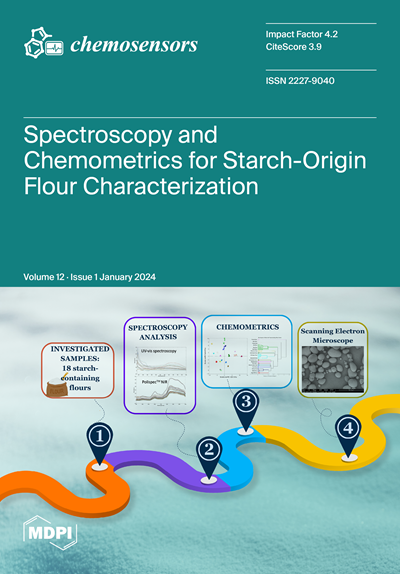Origami Paper-Based Electrochemical Immunosensor with Carbon Nanohorns-Decorated Nanoporous Gold for Zearalenone Detection
IF 3.7
3区 工程技术
Q2 CHEMISTRY, ANALYTICAL
引用次数: 0
Abstract
Nowadays, mycotoxin contamination in cereals and wastewater exposes a safety hazard to consumer health. This work describes the design of a simple, low-cost, and sensitive origami microfluidic paper-based device using electrochemical detection for zearalenone determination. The microfluidic immunosensor was designed on a paper platform by a wax printing process. The graphitized carbon working electrode modified with carbon nanohorns-decorated nanoporous gold showed a higher surface area, sensitivity, and adequate analytical performance. Electrodes were characterized by scanning electron microscopy, energy-dispersive spectroscopy, and cyclic voltammetry. The determination of zearalenone was carried out through a competitive immunoassay using specific antibodies immobilized by a covalent bond on the electrode surface. In the presence of HRP-labeled enzyme conjugate, substrate, and catechol, zearalenone was detected employing the developed immunosensor by applying −0.1 V to the working electrode vs silver as a pseudo-reference electrode. A calibration curve with a linear range between 10 and 1000 µg Kg−1 (R2 = 0.998) was obtained, and the limit of detection and quantification for the electrochemical immunosensor were 4.40 and 14.90 µg Kg−1, respectively. The coefficient of variation for intra- and inter-day assays was less than 5%. The selectivity and specificity of the sensor were evaluated, comparing the response against zearalenone metabolites and other mycotoxins that could affect the corn samples. Therefore, origami is a promising approach for paper-based electrochemical microfluidic sensors coupled to smartphones as a rapid and portable tool for in situ mycotoxins detection in real samples.基于碳纳米角装饰纳米多孔金的折纸电化学免疫传感器用于检测玉米赤霉烯酮
如今,谷物和废水中的霉菌毒素污染对消费者的健康造成了安全隐患。本研究介绍了一种简单、低成本、高灵敏度的折纸微流控装置,该装置采用电化学检测方法测定玉米赤霉烯酮。该微流体免疫传感器是通过蜡印工艺在纸张平台上设计的。用碳纳米角装饰纳米多孔金修饰的石墨化碳工作电极具有更高的比表面积、灵敏度和适当的分析性能。扫描电子显微镜、能量色散光谱和循环伏安法对电极进行了表征。利用共价键固定在电极表面的特异性抗体,通过竞争性免疫测定法测定玉米赤霉烯酮。在 HRP 标记的酶结合物、底物和儿茶酚存在的情况下,通过在工作电极上施加 -0.1 V 电压,以银作为伪参比电极,利用所开发的免疫传感器检测玉米赤霉烯酮。电化学免疫传感器的检出限和定量限分别为 4.40 微克 Kg-1 和 14.90 微克 Kg-1。日内和日间检测的变异系数均小于 5%。通过比较玉米赤霉烯酮代谢物和其他可能影响玉米样品的霉菌毒素的反应,对传感器的选择性和特异性进行了评估。因此,折纸是一种很有前景的纸基电化学微流控传感器方法,它与智能手机相结合,可作为一种快速、便携的工具,对真实样品中的霉菌毒素进行原位检测。
本文章由计算机程序翻译,如有差异,请以英文原文为准。
求助全文
约1分钟内获得全文
求助全文
来源期刊

Chemosensors
Chemistry-Analytical Chemistry
CiteScore
5.00
自引率
9.50%
发文量
450
审稿时长
11 weeks
期刊介绍:
Chemosensors (ISSN 2227-9040; CODEN: CHEMO9) is an international, scientific, open access journal on the science and technology of chemical sensors published quarterly online by MDPI.The journal is indexed in Scopus, SCIE (Web of Science), CAPlus / SciFinder, Inspec, Engineering Village and other databases.
 求助内容:
求助内容: 应助结果提醒方式:
应助结果提醒方式:


